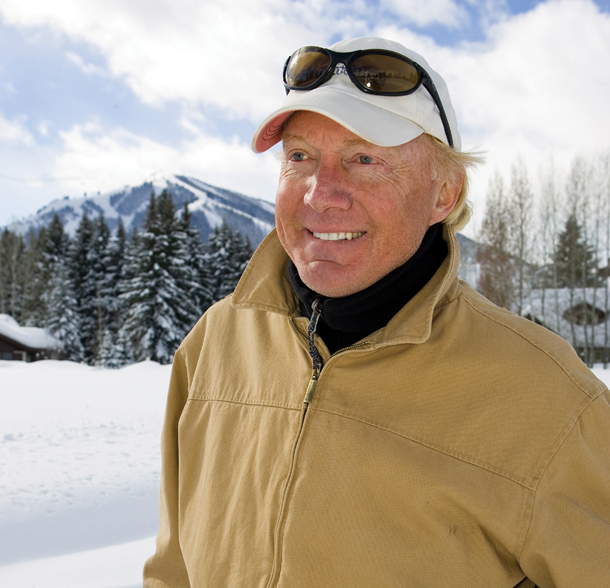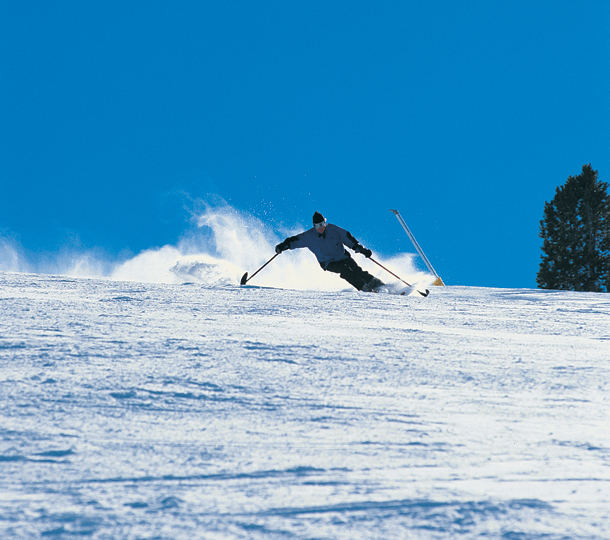| Current Issue |
| View as PDF |
| features |
| Feel the Burn |
|
The
New Western Sheriff |
| valley view |
| You are here |
| By the Numbers |
|
Where
Courage Counts |
| recreation |
| Fly Squirrel |
| Balancing Act |
| dining |
|
Confessions
of a Cocktail Snob |
| Chef's Specialty |
| arts |
| The Resurrection |
| The Hope Trigger |
| information directory |
| calendar |
| Winter 2009 |
| listings |
| Galleries |
| Dining |
|
Lodging,
Outfitters/ Guides & Equipment |
| the guide |
| Last Summer |
| Last Winter |
| Last Fall |
| Contact Us |
|
About
Us/ Contributors |

|
|
Copyright © 2008 Express Publishing Inc. All Rights reserved. Reproduction in whole or in part in any form or medium without express written permission of Express Publishing Inc. is strictly prohibited. The Sun Valley Guide magazine is distributed free four times a year to residents and guests throughout the Sun Valley, Idaho resort area communities. Subscribers to the Idaho Mountain Express newspaper will receive the Sun Valley Guide with their subscription. |


Almost overnight, at age 44, Mark
Thoreson’s way of life evaporated. With his equilibrium forever altered,
the once-hard charging athlete was on a cane, doubtful he would ever ski
again.
Balancing Act
Following a debilitating illness, ski instructor Mark
Thoreson was determined to conquer Baldy.
By Greg Moore. Photo by Chris Pilaro.
Mark Thoreson is an exceptionally graceful skier. But on a mountain with lots of good skiers, that’s not what sets him apart.
Until the fall of 1995, Thoreson took being an expert skier for granted. He had taught skiing at Sun Valley for the past 17 years and had become a top-notch windsurfer on the North Shore of Maui. With his blond hair, warm smile and surfer-boy good looks, he was the consummate Sun Valley athlete.
Then he had what he assumed would be a routine knee operation. But following the surgery, a staphylococcus infection set in. One day while riding in a car driven by his father, he suddenly felt the car lurching across the road. "Dad!" he yelled. "You’re all over the place!" His father replied that he was driving perfectly normally. "At that moment, my dad realized that something was not right," Thoreson said. "But I thought I’d get over it, that it would come and go. It never went away."
Thoreson was diagnosed with a profound destruction of his vestibular nervous system—the body’s gyroscope and its primary tool for balance. For the past 13 years, Thoreson said, "I’ve lived a life of vertigo and fatigue and nausea. I kind of feel like I’m floating off the ground."
The damage was caused by a combination of the bacterial infection and complications from the antibiotics used to treat it. Thoreson traveled the country searching for a doctor and a cure. During his visits to rehabilitation clinics, he saw patients with conditions just like his. Most spent the day in wheelchairs or behind walkers.
The realization slowly sunk in that his condition was permanent. Almost overnight, at age 44, his way of life had evaporated. The once hard-charging athlete was reduced to hobbling about with a cane. Malls and airports became nightmares—the open spaces and flowing crowds of people produced a dizzying sense of instability.
Though Thoreson tried to present a sunny demeanor to friends, he sank into depression, uncertain of what lay ahead of him.
In the summer of 1999, he received a call from his good friend Bill Clifford, asking him to come back to work for Sun Valley Company in the sales and marketing department, where the two had worked closely together before Thoreson’s operation. "I warned him I didn’t know how many hours I could give him in a day." Clifford said that didn’t matter—just come back to work.
Clifford had recently been diagnosed with a brain tumor, and his prognosis was not good. Partly for that reason, Thoreson took the job, and made the most of every opportunity to be with his friend.
"Bill and I would take these long walks and talk and talk. We talked about life. We talked about death. We talked about how we psychologically handle crises that are put before us. He was fighting the battle so courageously, but he was going down so fast. I knew that no matter what, I was going to make it. That became a huge motivator for me. That was the turning point, seeing his deterioration and thinking, ‘Hey, I might not be so bad off after all, because I’ll still be on this earth after Bill passes on.’"
Clifford died in January, 2001.
Thoreson continued to walk along Trail Creek in Sun Valley, where the two had spent so much time together. One winter day on the trail, he looked up at a hiker ascending Sun Peak. From his wobbly perspective, the ridge looked like it went on forever, and he couldn’t imagine climbing it. But he took two ski poles and began shuffling up the wind-packed ridge. The first time, he got about a quarter of the way up. Coming down was the scary part. He fell repeatedly.
But he kept at it, and one day he discovered he could slide down better than he could walk. The feedback from gravity’s pull actually improved his sense of balance.
He tackled the hill every day, and by early spring, he reached the summit. "When I started to hike Sun Peak I became more positive," he said. "I became more confident."
For the past few years, his friend Marc Mast, founder of the Sun Valley Ski School’s adaptive program, had been enouraging him to give skiing a shot again. "I was 99-percent sure he could do it with outriggers," Mast said.
After conquering Sun Peak, Thoreson agreed to go out to Dollar Mountain. He grabbed the outriggers—like crutches with little skis on the ends—and rode the Quarter Dollar lift. The once-admired expert was hoping he could slide the short, barely pitched slope to the bottom.
"It wasn’t a pretty sight," he said. "I fell hard when I got off the chair."
He felt humiliated, but returned for 10 days in a row and soon mastered a wedge turn. Mast, he said, acted like a video camera for him, telling him where his body was relative to the snow. Otherwise, Thoreson said, he could be leaning way back while thinking he was in an upright, athletic position.
On the day Dollar Mountain closed for the season, he skied it from the top. Now, Mast told him, it’s time for Baldy, which was still open.
"By now we had a whole string of people," Thoreson said. "It became kind of a circus. A lot of ski instructors were watching."

Mark Thoreson’s outriggers help him carve deep arcs. Photo by
Robbie Hilliard.
The two headed down College, the easiest run from the top. Thoreson fell repeatedly, but after about an hour, he reached the base. About 10 days later, on the day Baldy closed, he skied from top to bottom without falling.
"I went into the summer with the mental high that I knew I could ski Baldy."
For the next four seasons, he continued to improve. He built on the discovery he had first made on Sun Peak. "When I’m skiing, the pull of gravity kind of tells me where my body is. It gives me an orientation that I don’t have when I’m standing on flat ground." That and the four points of contact he got from his skis and the outriggers allowed him to stay upright.
Thoreson is more dependent than other skiers on having just the right equipment and the carving ski revolution had come at just the right time. Carving turns on the new skis, he built up resistance beneath his feet, which gave his body some sense of spatial orientation.
With his outriggers, Thoreson is easy to recognize on the hill, and skiers watching him from the lifts marvel at his progress from season to season. Rod Jones, a Sun Valley ski instructor who skied with Thoreson before and after his injury, said that at first, people were impressed merely by the fact that he was on the mountain.
"It was, ‘All right, Mark, you’re trying to ski!’ Then it got to be where he was just tipping, tipping, tipping. He got more and more into a carved turn with a lot of edge angle and a lot of body mass inside the feet. He not only came back to skiing, he came to absolute modern skiing."
While Thoreson’s skiing was improving dramatically, there was one problem—as soon as he stopped moving, he lost the added sense of stability provided by downhill motion. Jones calls that his albatross period; his landings were a disaster. "When he came to a stop, he’d just lose it," Jones said. Eventually, however, he mastered this, too.
Thoreson said he couldn’t honestly say he has as much fun skiing now as he did when he was healthy, but he does appreciate it more. "A lot of it is just being with my buddies and looking out at the Pioneer Mountains. Those are things I didn’t think I’d ever do again."
So far his recovery has been limited to skiing—in day-to-day life, not much has changed. Beyond walking, skiing is his only sport. He still gets fatigued from the concentration required to stay upright, and fights regular bouts of nausea. Daily life remains a challenge.
"But my attitude has changed," he said. "Skiing has been a huge part of that. It was the one thing I was able to sink my teeth into and get some huge results."
Thoreson occasionally thinks back to the patients he saw while traveling the country searching for a doctor—people who spent the day in wheelchairs.
"If you decide that that’s how you’re going to be for the rest of your life, your body shuts down and that is how you’re going to be for the rest of your life. The first step is the hardest, and the first step for me was hiking Sun Peak. The second step was a little easier, and the fourth and fifth steps easier still. Once you get your momentum, you’re on your way."